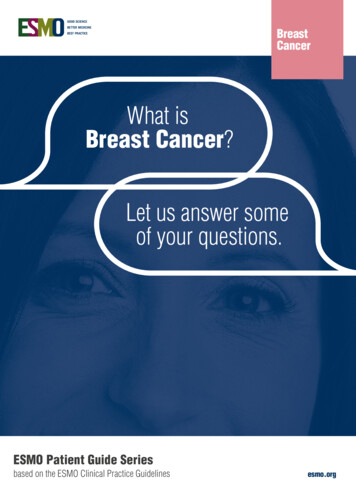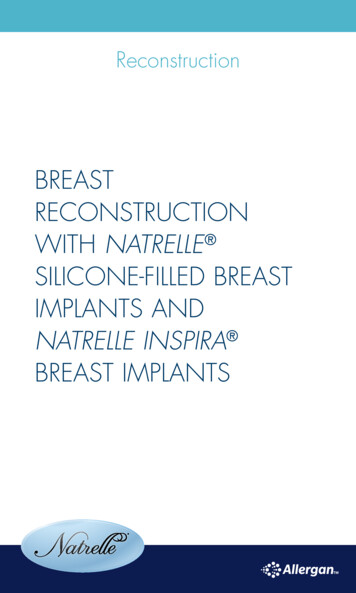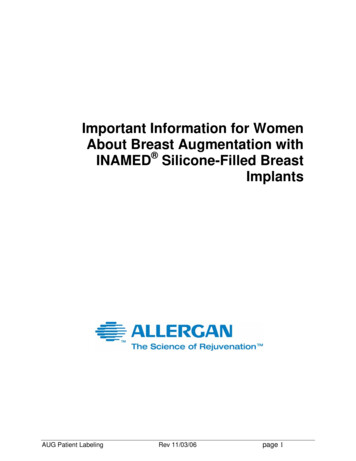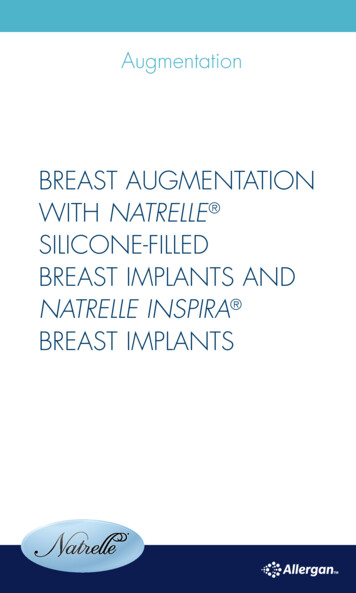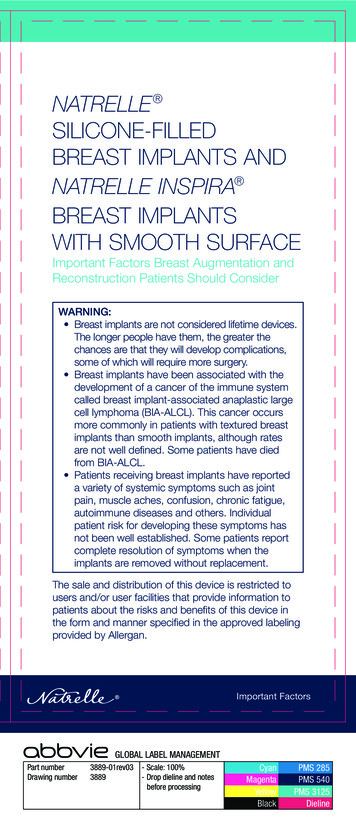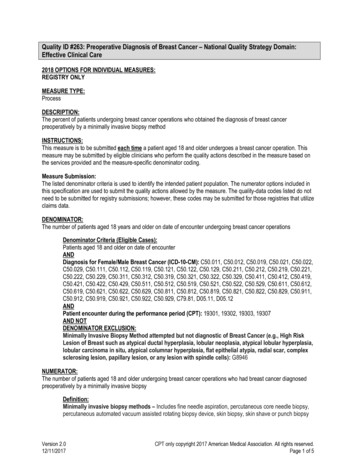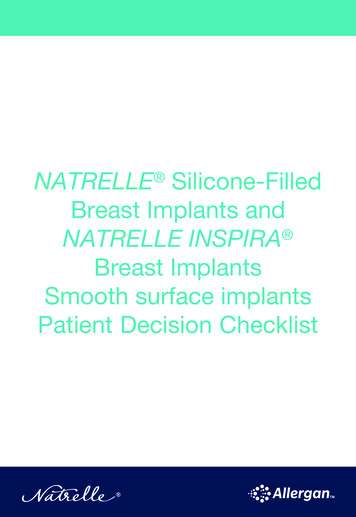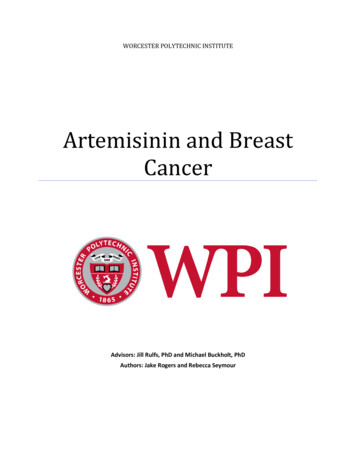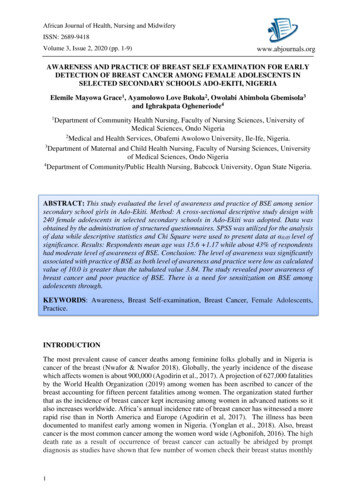
Transcription
African Journal of Health, Nursing and MidwiferyISSN: 2689-9418Volume 3, Issue 2, 2020 (pp. 1-9)www.abjournals.orgAWARENESS AND PRACTICE OF BREAST SELF EXAMINATION FOR EARLYDETECTION OF BREAST CANCER AMONG FEMALE ADOLESCENTS INSELECTED SECONDARY SCHOOLS ADO-EKITI, NIGERIAElemile Mayowa Grace1, Ayamolowo Love Bukola2, Owolabi Abimbola Gbemisola3and Ighrakpata Ogheneriode41Department of Community Health Nursing, Faculty of Nursing Sciences, University ofMedical Sciences, Ondo Nigeria2Medical and Health Services, Obafemi Awolowo University, Ile-Ife, Nigeria.3Department of Maternal and Child Health Nursing, Faculty of Nursing Sciences, Universityof Medical Sciences, Ondo Nigeria4Department of Community/Public Health Nursing, Babcock University, Ogun State Nigeria.ABSTRACT: This study evaluated the level of awareness and practice of BSE among seniorsecondary school girls in Ado-Ekiti. Method: A cross-sectional descriptive study design with240 female adolescents in selected secondary schools in Ado-Ekiti was adopted. Data wasobtained by the administration of structured questionnaires. SPSS was utilized for the analysisof data while descriptive statistics and Chi Square were used to present data at α 0.05 level ofsignificance. Results: Respondents mean age was 15.6 1.17 while about 43% of respondentshad moderate level of awareness of BSE. Conclusion: The level of awareness was significantlyassociated with practice of BSE as both level of awareness and practice were low as calculatedvalue of 10.0 is greater than the tabulated value 3.84. The study revealed poor awareness ofbreast cancer and poor practice of BSE. There is a need for sensitization on BSE amongadolescents through.KEYWORDS: Awareness, Breast Self-examination, Breast Cancer, Female Adolescents,Practice.INTRODUCTIONThe most prevalent cause of cancer deaths among feminine folks globally and in Nigeria iscancer of the breast (Nwafor & Nwafor 2018). Globally, the yearly incidence of the diseasewhich affects women is about 900,000 (Agodirin et al., 2017). A projection of 627,000 fatalitiesby the World Health Organization (2019) among women has been ascribed to cancer of thebreast accounting for fifteen percent fatalities among women. The organization stated furtherthat as the incidence of breast cancer kept increasing among women in advanced nations so italso increases worldwide. Africa’s annual incidence rate of breast cancer has witnessed a morerapid rise than in North America and Europe (Agodirin et al, 2017). The illness has beendocumented to manifest early among women in Nigeria. (Yonglan et al., 2018). Also, breastcancer is the most common cancer among the women word wide (Agbonifoh, 2016). The highdeath rate as a result of occurrence of breast cancer can actually be abridged by promptdiagnosis as studies have shown that few number of women check their breast status monthly1
African Journal of Health, Nursing and MidwiferyISSN: 2689-9418Volume 3, Issue 2, 2020 (pp. 1-9)www.abjournals.org(Agbonifoh, 2016)). It has been reported that early screening of cancer of the breast can bringabout the reduction of incidence rate of death among the affected persons (Agbonifoh, 2016).The minimum stage of detection breast cancer occurrence was 16 years whereas the highestage of occurrence was 42.6 years (Oluwatosin, 2012). Inadequate level of consciousness ofearly diagnostic procedures with the investigation of cancer of the breast was rampant inemerging countries (Hanna and Kangolle, 2010).This can be adduced as the reason why thepresentation of breast cancer usually comes up very late among the Nigeria women that beenaffected by this illness and very little or no effect of therapy could be derived from it.Even though there some concrete indications that signifies that the elderly women in emergingcountries usually come for late presentation of cancer of the breast (Rivera-Franco MM &Leon-Rodriguez, 2019). There is available data that reviewed the issues associated withinformation as well as opinions women have concerning the cancer of the breast and its care.This might be of help towards the therapeutic health searching behaviours (Azubuike, 2017).Unlike Clinical breast examination (CBE), and mammography in which the person has to visithospital along with the use of special equipment by trained personnel, BSE is not capitalintensive and can be easily examined by individual women themselves (WHO, 2019; Obaji etal., 2013). Several studies (Memon et al., 2015; Rahman et al., 2019; Philip et al, 2005) alsorecognized that constructive suggestion occurred in between investigation of breast selfexamination and early discovery of breast cancer. It has been revealed that most of the tumorsof the breast are self-known and many of them are through self-discoveries through BSE actors.(Birhane et al., 2017). The practice of breast self-examination is very important in the promptidentification of any changes in the breast. It has also been established that cancer can occur inwomen as young as sixteen years and the teenage period is a time in which some healthbehaviours could be entrenched, which would stay till adulthood (Kyle, 2013). Timelydiscovery of cancer of the breast could be achieved by enabling female students to be awareof BSE practices. This would make possible valuable interventional solutions for regulatingthe illness and eradicating the death rate (Kyle, 2013). Although studies have been undertakenamong various groups of populations in the world, targeting school teachers, young women,health workers, sex workers, pre-menopausal women, university students, and secondaryschool adolescents (Ndikubwimana et al; 2016), yet, little is documented about the practice andconsciousness of BSE within the female secondary students in Ado-Ekiti, Western Nigeria.This study therefore assessed the awareness and practice of BSE among female seniorsecondary school students in Ado-Ekiti, Nigeria.METHODOLOGYSelection of ParticipantsThe study adopted a cross-sectional descriptive study from January to March 2017. The studypopulation consisted of 240 students who were in the senior secondary (SS) classes (1–3) agedbetween 14 and 18 years. They were purposively selected because of the fact that they wouldhave reached puberty and would adequately fit into the study. One hundred and twenty girlseach were selected from Mary Immaculate Girls Grammar School and Christ Girls School;both in Ado-Ekiti. The SS1–3 students were selected by multi-stage clustering and simplerandom sampling. Permission was taken from the two School Authorities to conduct theresearch. Informed consent was taken with full pledge of confidentiality before conducting the2
African Journal of Health, Nursing and MidwiferyISSN: 2689-9418Volume 3, Issue 2, 2020 (pp. 1-9)www.abjournals.orgresearch work. Structured questionnaire were used to collect data which made up of foursections eliciting information about: socio-demographic characteristics (section A), awarenessabout breast cancer (Section B): Knowledge on early discovery of breast cancer with the useof breast self-examination (Section C), and exercise of breast self-examination (Section D).The instrument was pre-tested by the administration of the structured questionnaires to twentyfour SS 3 students at Fiwasaye Girls Grammar School, Akure Ondo state. The consistency ofthe instrument was tested through split-half method and Cronbach alpha reliability coefficientwhich was found to be 0.860. The questionnaire was appraised and essential adjustment weremade before the commencement of study. All completed questionnaires were collected andscreened for completeness manually by the investigator after which the frequencies of allvariables were computed. The data were analyzed using SPSS software version 20. Descriptivestatistics including percentages, frequencies, and measures of central tendencies and chi-squaretests were used to determine the degree of association of variables. All analyses were done at5% level of significance.Ethical Approval: All procedures were performed in compliance with relevant laws andinstitutional guidelines and that the appropriate institutional committees have approved them.Informed Consent: Informed Consent was taken from the School Principals and therespondents before administration of questionnaires.RESULTSTable 1 reflects the socio-demographic characteristics of respondents. A total of 120respondent each from Mary immaculate and Christ Girls School Ado Ekiti, making total of 240respondents from both schools. The respondents were all females (100%). The ages rangedfrom 14 to 18 years in the three senior secondary school (SSS) classes, with 35.0, 33.3 and31.7% of the respondents in SS1, 2 and 3 respectively. The mean age of the students was 15 1year, while majority (93%) were Christians and 92% of the students Yoruba.Table 2 shows the awareness of respondents concerning cancer of the breast. The studyrevealed that 29.6% of the respondent had good level of awareness of cancer of the breast,while 73.9% did not have knowledge that breast inspection could help in the timely recognitionof breast malignance. Also 49% reported that they are not conscious of how breast selfexamination (BSE) is being carried out, 32% reported that BSE is not necessary to be done byfemale. Sixty eight percent of the students acceptably acknowledged that breast cancer is anon-infectious communicable illness, 53% knew that breast suckling is not instrumental ofbreast cancer also 85% responded that malicious eye does not cause cancer of the breast.Nevertheless, around 17% of the students recognized that being overweight in some women,can increase the danger of developing breast cancer while 24% of the respondents knew thatlate child bearing at ages above 30 years amongst women could predispose them to havingcancer of the breast. Forty six percent of the respondents identified that use of oralcontraceptives increases the predisposition of women to breast cancer while 45% of therespondents recognized that a hard blow to the breast could cause cancer later in life. Fortyone percent among the students identified that majority of breast tumors are malignant. 34%reported they are too young to carry BSE out. 24% reported that it is difficult to remember todo while 39% reported that they have the fear of detecting abnormality. Finally, 39% of the3
African Journal of Health, Nursing and MidwiferyISSN: 2689-9418Volume 3, Issue 2, 2020 (pp. 1-9)www.abjournals.orgrespondents reported that they are afraid of exposing their self to the opposite sex. In the aspectof practice, merely 9.2% respondents practice BSE, 21.0% said they got their informationabout BSE through friends and 26.0% participants said via mass media, health personnel in31.0%, and others 22.0%.Table 3 revealed relationship among socio-demographic features and level of awareness ofBSE. The table showed that age and class of the participants were significantly associated withawareness of BSE while table 4 showed the relationship between socio-demographiccharacteristics and practice of BSE. The table revealed that there was a significant differencebetween the awareness and practice of breast self-examination, despite the level of awarenessyet the practice level was low (X2Tab 3.84 and X2cal 10).Table 4 revealed that Some of respondent at age of 16 -18 years 51% did not engaged in BSEalso 86% of Christian and 84% of Yoruba do not practice breast examination, among SS1, SS2,SS3 Student 34%, 30.8% and 25.8% didn’t practice the BSE, only very view student practiceBSE.The major why for not practicing breast self-examination include not having a breast problemin majority of the participants, some said they don’t think is necessary to do it and some saidsince they are not pregnant, they don’t need to examine their breast.From table 4, the hypothesis reviewed that there is significant relationship between levels ofawareness with practice of BSE. P 0.05DISCUSSIONSocio-Demographic Characteristics of Students in the Study Area.The mean age of 15.6 1.2 years shown in this study is in line with the structure of educationin Nigeria which necessitates students to move in to secondary school at the age of 12 yearsand finish at the age 18 years. This was slightly lesser to the mean age of 16.0 0.9 yearsdocumented in a research work in Turkey among senior school students (Karayurt et-al, 2014).There was significant relationship between age and knowledge scores. This is in agreementwith (Nwaneri et al, 2017) who reported that older women expressed lower knowledge of riskfactors about cancer of the breast among cross section of British women which was clearlyshown amidst women of lower social economic status (SES).Majority of respondents had a little awareness of breast cancer which is in agreement to studyconducted in Abuja (Isara & Ojedokun, 2011). This might be attributed to the fact that Abujais a more cosmopolitan environment than Ado-Ekiti, similar findings were reported at Tanzaniaby Ngida et al., 2019 that the majority of the participants had never heard of BSE. The role ofteachers in disseminating information about BSE among secondary school students could notbe over emphasized as this study has shown the poor input of teachers as a major source ofinformation. Educating teachers about breast cancer enhances the dissemination of accurateinformation on breast cancer to the students as early as possible. BSE practice among the studypopulation was poor, the major reason being the lack of knowledge of its performance.Oluwatosin and Oyedepo, 2012; Karayurt et-al, 2016 also documented the poor practice ofBSE across all age categories in different research works in Nigeria and globally. It is however4
African Journal of Health, Nursing and MidwiferyISSN: 2689-9418Volume 3, Issue 2, 2020 (pp. 1-9)www.abjournals.orgcreditable to observe the readiness of the girls to practice BSE if trained. An argument for theprovision of interventional programmes to be made available for this particular age categorywould be a welcome development. This is a pointer to Health Educate Teachers on the need toextend the facts about BSE to younger women as against the older women who are perceivedto be more vulnerable. This is because imbibing prompt social configurations about BSEpatterns and having acceptable level of facts and exhibitions for these young adults is importantto guarantee accurate and active practise of BSE presently and in the future. Anotherexplanation given by the respondents for not carrying out the practice of BSE was the lack ofawareness to being susceptible to cancer.The lack of awareness about the ailment could be attributed to low level of knowledgeincluding related risk factors. There was significant association between the awareness of BSEand practice. This was in line with similar study by Isara & Ojedokun (2011) who reported thatthe respondents who had a good awareness of BSE practiced it more than those who did not.This was not in agreement with other studies in Nigeria and Iran among older women (Faronbi& Abolade 2012). Increased awareness of cancer of the breast and BSE is essential to kick startinterest in taking more concrete steps towards health changing behavior among this group ofindividuals. This could be achieved by educating the teachers so that they can enhance thepractice of BSE among the students. The younger the age, at which females have been exposedto facts and knowledge of BSE, the greater the likelihood of compliance to the practice of BSEin the future. Sufficient awareness and screening practices of breast cancer can help in earlydetection of cancer of the breast can and low practice of BSE in an emerging Nation such asNigeria.Implication to ResearchThe findings revealed low awareness level of the female secondary school student, adequateperiodic interventional programmes targeting young girls should be built into the schoolcurriculum regarding BSE. Information can also be channel to the Parent during their ParentTeacher Association (PTA) meetings. Information, education and communication materials(IEC) can be made used of in the school’s environment, all these can serve as interventions tohelp in reduction of breast cancer in our societyCONCLUSIONSThe outcome of this research showed the inadequate awareness of cancer of the breast and itsrelated risk factors which cumulates in the poor practice of BSE among Senior FemaleSecondary School Students in Ado-Ekiti, Nigeria. Once the awareness of BSE among thestudents is achieved, it will enhance the early detection of Breast cancer and this practice wouldbe a potentially useful approach for controlling the disease and reducing mortality.Conflict of InterestThere was no conflict of interest within the authors5
African Journal of Health, Nursing and MidwiferyISSN: 2689-9418Volume 3, Issue 2, 2020 (pp. 1-9)www.abjournals.orgFUTURE RESEARCHThere should be further educational intervention Programme on the knowledge of BSE on theawareness of breast tumor in other to prevent breast cancer. There should be a further study onevidence base practice BSE related to cancer and its risk factors.REFERENCESAgbonifoh, J. (2016) A Breast Self-Examination Practice among Female Students of TertiaryInstitutions Journal of Education and Practice 7(12):11-18.Agodirin S.O. Akande J .H. Olatoke A .S., Rahman A.G & Oguntola A.S Level of Awarenessand Knowledge of Breast Cancer in Nigeria. A Systematic Review Ethiop J HealthScience. 27(2): 163–174.Azubuike S.O., Muirhead C., Hayes L & McNally R. Rising global burden of breast cancer:the case of sub-Saharan Africa (with emphasis on Nigeria) and implications for regionaldevelopment Word Journal of Surgical Oncology 16: 63.Birhane, K, Alemayehu, M, Anawte, B, Gebremariyam, G Ruth Daniel, R, Addis, S Worke,T Mohammed, A and Negash, W (2017) Practices of Breast Self-Examination andAssociated Factors among Female Debre Berhan University Students InternationalJournal of Breast Cancer https://doi.org/10.1155/2017/8026297Faronbi, J.O and Abolade, J (2012) Breast Self-Examination practices among femalesecondary school teachers in a rural community in Oyo State, Nigeria Open Journalof Nursing 2: 111-115 http://dx.doi.org/10.4236/ojn.2012.22017Hanna T.P. and Kangolle, A.C.T. (2010) Cancer Control in Developing Countries: UsingHealth Data and Health Services Research to Measure and Improve Access, Quality andEfficiency. BMC International Health and Human Rights, Journal of cancer therapy10- 24. http://dx.doi.org/10.1186/1472-698X-10-24.Isara, A.R and Ojedokun, C.I (2011) Knowledge of Breast Cancer and Practice of BreastSelf-Examination among Female Secondary School Students in Abuja Journal ofPreventive Medicine and Hygiene52:186-190Karayurt.O (2014) Prevention and management of lymphedema related to breast cancer I:https://doi.org/10.1016/S1462-3889(14)70053-5 18:59Memon Z.A, Kanwa N., Sami M. Larik P. A. Farooq M. Z. (2O15). Risk of BreastCancer among Young Women and Importance of Early Screening. Asian Pacific Journal ofcancer Prevention, 5.Molly J and Mercy P.J., (2016) Effectiveness of a structured teaching programme onknowledge of breast cancer and skill of breast self-examination: a quasi-experimentalstudy in rural women l 3: 10Monica M., Rivera-Franco., Leon-Rodriguez E. Delays in Breast Cancer Detection andTreatment in Developing Countries Sage ikubwimana, J, Nyandwi1, J. B, Mukanyangezi1, M.F and Kadima, J.N (2016) BreastCancer and Breast Self-examination: Awareness and Practice among Secondary SchoolGirls in Nyarugenge District, Rwanda International Journal of Tropical Disease andHealth12 (2): 1-9.Ngida F.D, Kahorol G.L, Nwangi R, Mebelele M.M, Kitau J, Mahande M.J (2018),Knowledge and practices on breast cancer detection and associated challenges among6
African Journal of Health, Nursing and MidwiferyISSN: 2689-9418Volume 3, Issue 2, 2020 (pp. 1-9)www.abjournals.orgwomen aged 35 years and above in Tanzania: a case in Morogoro Rural District Breastcancer targets and therapy 11Nwaneri A., Osuala E.O., Okpala PU., Emesowum AC., Iheanacho P. (2017). Knowledgeand sawareness of breast cancer among rural women in Umuowa Orlu LocalGovernment Area Imo State, South East, Nigeria. 20(4): 489-494.Nwafor C.C & Nwafor N.N (2018) The pattern and distribution of cancers in Akwa IbomState, Nigeria Nigeria journal of Clinical Practice 21 (5):603-608Obaji, N.C, Elom, H.A, Agwu, U.M, Nwigwe, C.G, Ezeonu ,P.O, Umeora, O.U(2013)Awareness and Practice of Breast Self‑Examination among Market Women inAbakaliki, South East Nigeria Annals of Medical and Health Sciences Research 3(1):712Oluwatosin. O. (2012) Primary Health Care Nurses’ knowledge practice and client teachingof early detection measures of breast cancer in Ibadan 11:1-8.World Health Organization (2019). Breast cancer: Early diagnosis and screening.https://www.who.int/cancer/ ahman, S.A, Marzouki, A. A, Otim, M. Hoda, N., Khayat, K., Yousef R, Rahman P. 2019.Awareness about Breast Cancer and Breast Self-Examination among Female Studentsat the University of Sharjah: A Cross-Sectional Study. Asian Pacific Journal of CancerPrevention DOI:10.31557/APJCP.2019.20.6.1901.Zheng Y., Walsh T. & Olopade I.O (2018) inherited Breast Cancer in Nigerian Women,Journal of clinical oncology7
African Journal of Health, Nursing and MidwiferyISSN: 2689-9418Volume 3, Issue 2, 2020 (pp. 1-9)www.abjournals.orgAPPENDIXTable 1: Socio-Demographic Characteristics of RespondentsVariableAge ReligionChristianIslamFrequency (N 240)Percentage 1494.25.8Table 2: Respondents Awareness of Breast CancerAwareness Table 3: Relationship between Socio-demographic characteristics and level of Awarenessof BSEAwareness of Breast Self-ExaminationPValueVariableAge in mEthnicityYorubaIbo8Good (%) Average (%)Poor (%)Total (%)XcalXtab29 (12.1)42 (17.5)31 (12.9)71 (29.6)41 (17.1)26 (10.8)101 (42.1)139 (57.9)15.785.99 0.0539 (16.3)19 (7.9)13 (5.4)17 (7.1)29 (12.1)56 (23.3)28 (11.7)32 (13.3)7 (2.9)84 (35)80 (33.3)76 (31.7)55.439.49 0.0566 (27.5)5 (2.1)100 (41.7)2 (0.8)60 (25.0)7 (2.9)226 (94.2)14 (5.8)5.567.38 0.0568 (28.3)3 (1.25)92 (38.3)10 (4.2)62 (25.8)5 (2.1)222(92.5)18 (7.5)1.825.99 0.05
African Journal of Health, Nursing and MidwiferyISSN: 2689-9418Volume 3, Issue 2, 2020 (pp. 1-9)www.abjournals.orgTable 4: Relationship between Socio-demographic characteristics and practice of BSEVariableAge in mEthnicityYorubaIboAwarenessGoodPoor9Practice of Breast Self-ExaminationYesNoXcalXtabN (%)N (%)7(2.9)15 (6.3)94(39.2)124(51.6)2(0.8)6 (2.5)14 (5.8)182(34.2)74 (30.8)62 (25.8)19 (7.9)3(1.25)1.04P Value3.84 0.0512.915.99 0.05207(86.3)11 (4.6)2.643.84 0.0520 (8.3)2(0.8)202(84.2)16 (6.6)0.093.84 0.0522 (9.2)19 (7.9)54 (23)145 (60)10.003.84 0.05
yet the practice level was low (X2 Tab 3.84 and X2 cal 10). Table 4 revealed that Some of respondent at age of 16 -18 years 51% did not engaged in BSE also 86% of Christian and 84% of Yoruba do not practice breast examination, among SS1, SS2, SS3 Student 34%, 30.8% and 25.8% didn't practice the BSE, only very view student practice BSE.
